Where do the kana come from
The simple answer to this question is: "from kanji". While kanji are used as semantic symbols in modern Japanese, this hasn't always been the case, as kanji were quite often used purely for phonetic purpose, using whatever kanji was available to get the sound of the what was written down across without paying attention to the meaning of the actual kanji used. Through this use a "standard" set of kanji became used to mimic Japanese phonetics, and it is from this set that hiragana and katana were derived.
Hiragana was derived from the cursive forms of kanji, and was used predominantly by women, while katakana was derived from lifing kanji compounds out of their kanji and using them as phonetic characters instead. This script was deemed unsuited for women and was used by men, as well as in the clergy (which at the time of course constisted only of men anyway)
In order to - for most - syllables show which kanji they were derived from, each kanji is show in a progressively more "relaxed" fashion. The first of the four kanji is in block style, the second in semi-cursive style, the third and fourth in cursive and very cursive style respectively. You may notice there is are a few gaps in for third kanji forms, which is mainly because I don't have $500 to buy the complete version of the hakushu sousho font to fill them (I wish fonts weren't priced for industrial use).
The three hiragana syllables are in minchou, and two hand written fonts, to show you that even if they are modern syllables, there are still differences between print and hand written form.
The katakana derivation images are a bit simpler, and just show you the kanji that the katakana syllable was "lifted" from, with the relevant part of the kanji highlighted in red.
あ行
The あ column syllable derivations come from 安, 以, 宇, 衣 and 於 for あ, い, う, え and お respectively. い comes from the left compound of the cursive form of 以, for え the very cursive form is no longer really indicative, but the normal cursive form shows a reshaping to え. For お, imagine the cursive form connecting up the compounds.
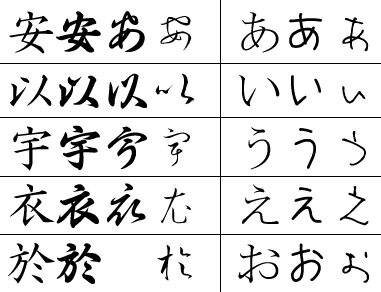

か行
The か column syllable derivations come from 加, 機, 久, 計 and 己 for か, き, く, け and こ respectively. き is a bit of a mystery, and to be honest I cannot tell you how on earth it became what it is now.
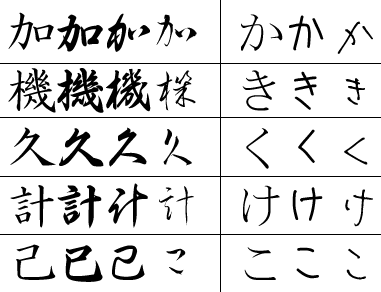
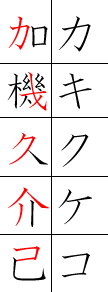
さ行
The さ column syllable derivations come from 左, 之, 守, 世 and 曾 for さ, し, す, せ and そ respectively. し is another one of those hard to imagine derivations, so you'll just have to take my word for it I suppose... せ is more obvious from its cursive than very cursive form, and そ requires a bit more simplification in its form to really show its derivation. Don't ask me how ス comes from 須 because I honestly don't see it either... but the literature says that's the way
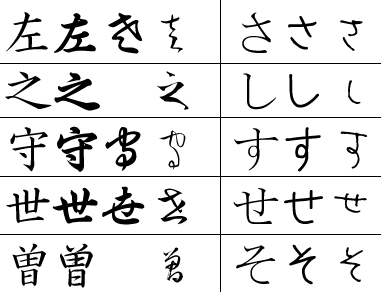

た行
The た column syllable derivations come from 太, 知, 川, 天 and 止 for た, ち, つ, て and と respectively. つ is not really obvious, but there is an ever more relaxed cursive form that simply joins up all three strokes, which makes the derivation much more sensible (sadly, I lack a font that shows this, and a scanner to scan this particular form from a book). と is also a rad hard to imagine, but imagine the second, third and fourth stroke in 止 to become one brush stroke and you're essentially there.

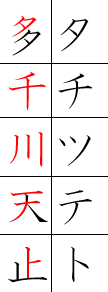
な行
The な column syllable derivations come from 奈, 仁, 奴, 祢 and 乃 for な, に, ぬ, ね and の respectively. ね might seem a bit odd, but if you look at the hiragana ふ you can see how the right component might easily become a single line with a curl back over itself.


は行
The は column syllable derivations come from 波, 比, 不, 部 and 保 for は, ひ, ふ, へ and ほ respectively. Again the very cursive form is a bit useless, this time for ひ, but the normal cursive form shows the "logic" of the derivation. The derivation for へ on the other hand is about as magical as the one for き, earlier. I cannot quite tell you how it happened so you'll just have to believe this one too.
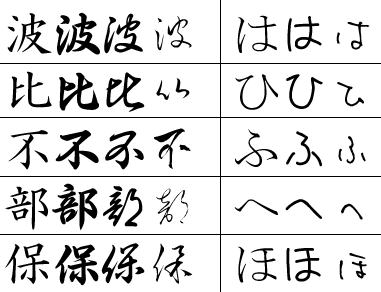

ま行
The ま column syllable derivations come from 未, 実, 武, 女 and 毛 for ま, み, む, め and も respectively. み seems odd, but some further relaxation gets us pretty close to the hiragana form. む on the other hand seems obvious from the very cursive form, but there doesn't seem much logic in going from cursive to very cursive. cursive form doesn't stick to stroke order, but will reorder strokes so that a cursive stroke can cover several shapes in a different order, but less stroking so that's basically what happened here too.
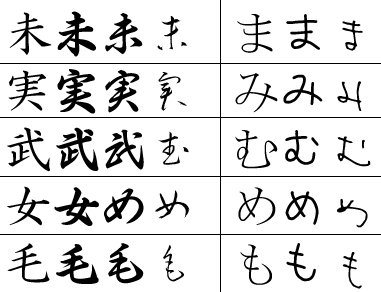

や行
The や column syllable derivations, only three of them of course ("yi" and "ye" have never existed, they were always just い and え, ever since the dawn of the Japanese writing system), come from 也, 由 and 與 for や, ゆ and よ respectively. For ゆ there is the interesting sidenote that the minchou font used does not show the "fully connected" form, but the "shortcut" version that is used in handwriting too. The fuller version has both strokes connected, by making the curl on the first stroke loop around left to connect to the top of the vertical stroke.
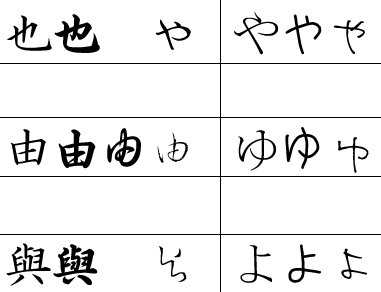
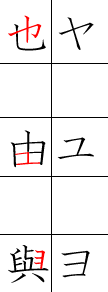
ら行
The ら column syllable derivations come from 良, 利, 留, 礼 and 呂 for ら, り, る, れ and ろ respectively. り requires a bit more relaxing before the derivation makes sense, but る is an excellent example of how you can turn a complex kanji into a ridiculously simple stroke. ろ definitely requires more work: imagine simplifying the top ロ to essentially a collapsed single small stroke, and then combining it with the lower ロ, which you simplify to a 冂 form instead... and then we have a ろ like character.

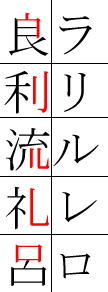
わ行
The わ column syllable derivations, four of them because there used to be four, come from 和, 爲, 惠 and 遠 for わ, ゐ (wi), ゑ (we) and を respectively. For わ, imagine that the right compound is smoothed into a single line with a left serif as the brush is lifted off the paper. curve the line a little, make the serif part of the line, and you're pretty much at a わ. Also, を is another great example of how cursive style completely disregards the "official" stroke order.
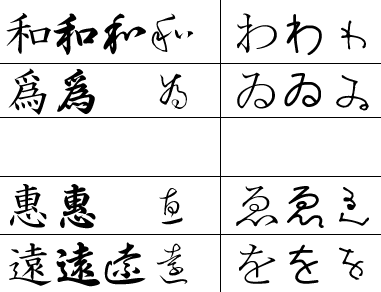
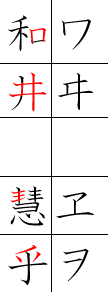
ん
The ん and ン don't really form a column, but here's their derivations anyway:
